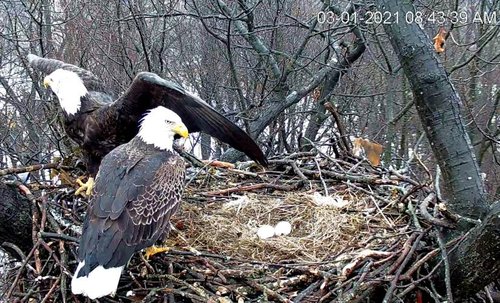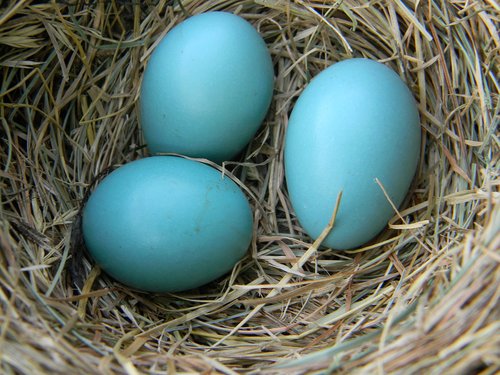Hanover Bald Eagles Blog # 9 - 2021
In partnership with Pennsylvania Game Commission and Comcast Business .
The question of bird egg coloration plagued the curious minds of natural historians for decades, partially because the how and why was, and still is, difficult to prove. When bird eggs were first structurally examined by oologists (people who study eggs) in the 1870s, debates cropped up. Some people thought that coloration in bird eggs was merely an accidental “byproduct” of the laying process. Later, oologists verified that coloration was the result of physiological processes that occurred inside the bird prior to laying, and that in fact eggs were essentially painted with different pigments before they emerged into the waiting world.
However, this only addressed the how of egg coloration. The why remained an intriguing puzzle, because each bird species has a different evolutionary story and therefore a different set of reasons for why they do what they do, and why they lay what they lay.

There are two types of egg-layers in the animal kingdom, and their names are painfully similar: anamniotes are animals that lay eggs in water, such as amphibians and fish. Amniotes, such as birds and reptiles, lay eggs on land. However, birds are the only amniotes whose eggshells are sometimes colored.
Bird eggshells are composed of a substance called calcium carbonate, which is naturally white. Producing pigments requires the female to invest energy, and therefore the rewards of coloring an egg must be worth the energy it requires to produce the coloring.
One main reason why eggs are colored is to avoid detection by predators: The more camouflaged a clutch of eggs, the less likely they are to be consumed by a hungry predator. Take the kildeer for example, a medium sized member of the plover family that usually lays its eggs directly on gravel, with nothing more than a small indentation in the ground holding them in place. These eggs blend into their environment remarkably well. And, if camouflage isn’t enough, kildeer parents will pretend to have a broken wing to lure the approaching predators away from the eggs, distracting them from discovering the location of the nest.

Killdeer Eggs. Credit: Creative Commons
Other birds such as American robins, have conspicuous and easily detectable eggs that scream out for attention in all their glorious robin-egg blue. How can a robin afford to lay such noticeable eggs?

Robin Egg Blue. Credit: Laslo Varga
One hypothesis is that perhaps by having such noticeable eggs, robins are able to spot “intruder” eggs more easily, and avoid falling victim to nest parasitism, which is when one species lays their eggs in the nest of another species and therefore avoids having to raise their own offspring (rude, but ingenious). Robins are known as “rejectors,” meaning they quickly dispose of intruder eggs. This could be because in a clutch of bright blue eggs, an imposter is easy to recognize.
Another possible explanation for robin-egg blue is light absorption: Scientific experiments have shown that blue eggshells absorb more light than other colored shells, and therefore may aid in speeding up the process of embryonic development.
Another hypothesis is that brightly colored eggs may signal that a healthy female has laid them. A male, noticing this, may be more likely to step up his game and provide for her. And, in fact, one study demonstrated exactly that. Male robins in the study provided more food to chicks that came from bright blue eggs than for chicks that came from pale blue eggs!
Some species, such as the common murre, lay eggs with incredible color and pattern variation even within the same clutch. Murres are colonial nesters, with thousands of individuals breeding together on sea cliffs or islands, and therefore this coloration uniqueness is thought to help parents identify their own nest more easily, so they don’t accidentally plot down on their neighbor’s nest instead of their own.

A sampling of pigment variation in common murre eggs. Credit: Creative Commons
So how do all of these elements of egg coloration relate to the Hanover pair?
Which of these concerns would matter to bald eagles?
- Predation
- Blood parasitism
- Identification of their own eggs
You guessed it - none of these are a big issue for bald eagles. Of course, predators are of some concern, since great-horned owls, crows, ravens, gulls, and some tree-climbing mammals like racoons are potential nest predators. But due to the extreme heights of most eagles nests, their aggressive behavior, large size, and consistent presence in the nest, the chance of a predator snatching eagle eggs is significantly lower than for many other bird species.
Brood parasitism is not very common in raptors, and I for one would choose many other host parents before attempting to trick a bald eagle. Bald eagles do not need to worry about identifying their own eggs over those of their non-existent next-door neighbors.
So, with these considerations in mind, the fact that bald eagles lay white eggs makes a lot of sense. They begin incubating as soon as the first egg is laid, and the nest is high enough few predators could locate the eggs using sight alone. Some researchers theorize that white eggs do a better job of dispelling solar radiation to protect the embryo from overheating, but this has not yet been proven for bald eagle eggs.
The scientific community still has much to learn about the details of eggs, and raptor eggs are particularly mysterious due to the secretive tendencies of adults and the logistically complicated study protocols required to investigate a nest. Most of what we know of bird eggs comes from poultry studies, colonial seabirds, and/or analysis of museum displays.
What we can surmise is that bald eagle eggs are white for a reason, and that so far, their simple color scheme has been working!
Fun Fact: In 2017 a red-tailed hawk (eventually named Spunky) was successfully raised by a bald eagle pair in British Columbia. No one is sure what this means in bird world, but it was a captivating and thought-provoking story. Story here
Hanover Development Update
Egg #1 is on day 27 of development, and egg #2 is on day 24. This means that both chicks now have talons, closed eyelids, scaled legs, and are starting to look like birds!

RETURN TO HANOVER BALD EAGLE BLOGS
WATCH THE HANOVER BALD EAGLE LIVE CAMS
For over 20 years, HDOnTap has provided live streaming solutions to resorts, amusement parks, wildlife refuges and more. In addition to maintaining a network of over 400 live webcams, HDOnTap specializes in design and installation of remote, off-grid and otherwise challenging live streaming solutions. Contact press@hdontap.com for all media needs, including images and recordings.